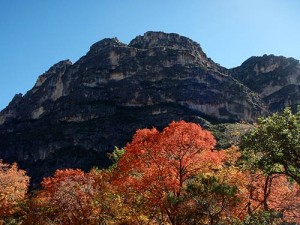By Lizzie Wasilewska
Guadalupe Mountains National Park, which lies on the Texas-New Mexico border, may not be a very well-known park, but it is nonetheless a fascinating and beautiful one. From a distance, it appears as a series of majestic mountains breaking up the desert landscape; close up, it reveals a range of smaller wildernesses, ranging from salt flats to glades to forests, all of which are populated with an abundance of wildlife.
The park’s birthday — which is today — occurs during one of its most beautiful times of the year. Every fall, thousands of visitors visit the park’s McKittrick Canyon to view the turning bigtooth maples, dramatically framed by the surrounding desert and blue skies. The canyon’s spring-fed oasis creates an inviting habitat not only for the maples but for a variety of wildlife including mountain lions, wild turkeys, black bears and elk. The bigtooth maples are one of many species of trees that thrive in the park despite its harsh desert conditions. To the west, species including pinyon pine and junipers grow in lower elevations; canyon interiors are home to species including maple, ash and oak; pine and aspen grow in the alpine uplands. A variety of factors, including the springs of water that are recharged by wet uplands, contribute to the park’s diversity of plants and animals.
In 1959, the petroleum geologist Wallace E. Pratt decided that this region deserved wider recognition and protection. He donated 4,988 acres of his ranch in McKittrick Canyon to the National Park Service, and other landowners followed suit; eventually, writers, senators, governors, and congressmen gathered together in an effort to establish the region as a national park. They were not without opposition: Many ranchers relied on the land for income and were reluctant to move on. Nonetheless, on October 15, 1966, Lyndon B. Johnson signed the establishing act, and in 1972, the park was opened to the public. Some opposition from the area’s ranching community continues to this day; their land is now used as a buffer zone that protects the fragile ecosystem of this park.
American Forests recognizes the importance of the role that local communities play in protecting ecosystems, which is why we work with local partners on our tree planting and restoration efforts. The efforts of local communities help to ensure bright futures for ecosystems like Guadalupe Mountains National Park.

